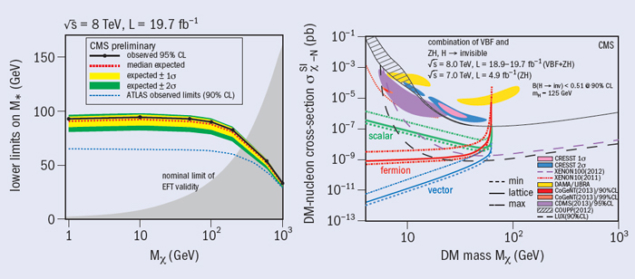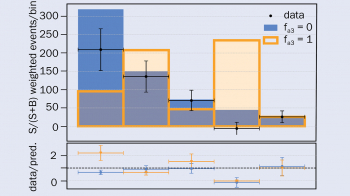With the discovery of a Higgs boson at the LHC two years ago, the last piece of the Standard Model puzzle fell into place. Yet, several mysteries remain, one of which is the enigma of the origin of dark matter. One of the most popular classes of models predicts that the dark matter is made of weakly interacting neutral and colourless particles, χ, with mass ranging from a few to a few hundred giga-electron-volts. The LHC, with its high-energy collisions, provides an excellent pace to search for such particles, and the CMS collaboration has been taking a new look at ways in which they could be produced.

Until recently, the main experimental method to look for dark-matter particles was to exploit their elastic scattering on nuclei inside sensitive detectors, working typically at low temperatures. These direct-detection experiments aim to observe the scattering by measuring the momentum of the recoiling nucleus. While interesting hints for dark-matter detection in various mass ranges have been reported by some of these experiments, none of these hints have been confirmed by later, more precise measurements.
Several years ago, a new idea appeared: to look for the production of pairs of dark-matter particles in high-energy particle collisions, like those at the LHC, via a process described by the same Feynman diagram as the scattering of the dark-matter particles on quarks inside the nuclei, but “rotated” by 90°. While such direct-detection experiments look for the process qχ → qχ, experiments at the LHC can look for qq → χχ. The challenge is to trigger on these events, because dark-matter particles would leave no trace in the detector. One possibility is to search for a more complicated process, where an additional particle, for example a gluon or a photon, is produced together with the dark matter.
The CMS experiment has performed a number of such searches, which are referred to collectively as mono-X searches, because they look for a single object, X, recoiling against the invisible particles. Recently, these searches have been extended to more complicated signatures, for example the production of dark matter in association with a pair of top quarks, which are produced in abundance at the LHC. The new analysis looks for top-quark pairs that are recoiling against a large amount of “missing” transverse momentum, carried away by dark-matter particles.
As figure 1 shows, a new measurement by CMS of the production of top-quark pairs in association with missing transverse momentum sets stringent limits in the plane of the dark-matter particle mass Mχ vs an effective interaction energy scale, M* (CMS Collaboration 2014a). The interaction of dark matter with the known particles is usually assumed to be carried by new “messenger” particles. If the messengers are heavy – which would be a good reason why they have not yet been seen – the interaction can be approximated via a point-like interaction with an effective energy scale of M*. This is similar to Enrico Fermi’s effective theory of muon decay, where the messenger – a W boson – is much heavier than the muon.
Another interesting way to look for dark matter is based on precision measurements of the properties of the Higgs boson. If the mass of the dark-matter particle is less than roughly half of the Higgs boson mass, for instance, Mχ < 60 GeV, then it is possible to look for a direct decay of the Higgs boson into a χχ pair. This decay is called “invisible” because its products are not detected.
The CMS collaboration recently published a search for such invisible Higgs-boson decays, where the production of the Higgs is tagged either by the presence of a Z boson (associated ZH production), or by the presence of two forward jets, characteristic of vector-boson fusion (CMS Collaboration 2014b). The upper limits set on the invisible branching fraction of the Higgs boson are 51% and 58% at a 90% and 95% confidence level, respectively. The former limit can be translated to limits on the mass of the dark-matter particle vs its interaction cross-section with a nucleon, which allows for a direct comparison with the limits coming from various direct-detection experiments, as figure 2 shows. The limits are set for various types of dark-matter particle: scalar, vector, or a Majorana fermion. They are significantly more stringent than the direct-detection limits for low masses for dark matter, emphasizing the complementarity of the searches by the LHC and the direct-detection experiments.
Further reading
CMS Collaboration 2014a PAS B2G-13-004: https://cds.cern.ch/record/1697173?ln=en.
CMS Collaboration 2014b submitted to EPJC, arXiv:1404.1344.








